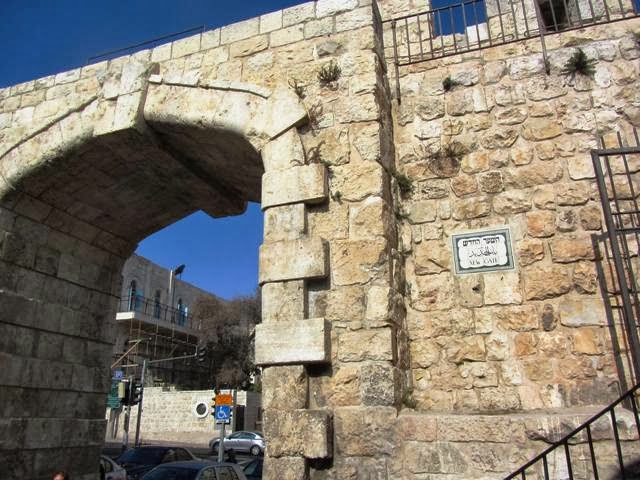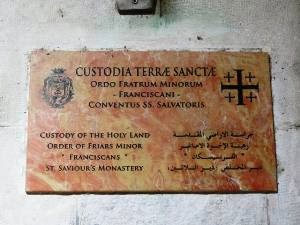My wife and I signed up for a four-session touring course on "Minorities in the Old City of Jerusalem" and the first visit was to the Christian Quarter, to learn about the role the Catholics play in the Holy City. The tour had been organized by Zman Eshkol, the leading operator of leisure studies in Israel, and our guide for the day is Esther Sa'ad.
Two percent of Israel's population is Christian, and most of them are Arab Christians (Arab is the nationality, Christianity is the religion). 15% of the Christians in Israel are Catholics. The first Catholics arrived with the Crusaders in the 11th Century. In the 13th-14th Century, the Franciscan Order, adherents of the spiritual teachings of Saint Francis of Assisi, was given the mission to protect the holy sites in the name of the Pope.
Our first stop is at Terra Sancta, a Franciscan monastery just inside the New Gate. The New Gate was cut out of the Ottoman walls at the end of the 19th century to allow better access to the Church of the Holy Sepulchre.
 |
| The New Gate |
 |
| A winding street in the Christian Quarter |
 |
| The Terra Sancta church |
 |
| Oscar tells us why he became a Franciscan monk |
The Terra Sancta church is a typical Catholic church with statues, religious paintings, a very large organ, a central altar and small altars on the sides. Originally the side altars allowed the monks to pray separately, but later they began praying together. Masses take place in Italian and Arabic.
We talk with Oscar in the monastery's "treasure room", a museum-like collection of crosses, sculptures and carvings. Oscar tells us that the first monks were those who took to the deserts of the Holy Land in ancient times. Franciscans see themselves as custodians both of the holy sites as well as of the Holy Land's Christian community, the "living stones".
We asked Oscar how he had become a monk. He told us that for believers, to become a monk is a calling. Twelve years ago Oscar met with other monks and realized that he wanted to be 'happy' like them. He took a temporary vow for 6 years, and then a permanent vow. As Oscar had studied Middle Eastern Studies, he ended up serving in the region. His first position was in Ein Kerem, and now he was being called back to Rome.
There are three Franciscan monasteries in the Old City and 10 more outside the walls in Jerusalem. Until the middle of the 19th century, they were the only Christian order in the land. In 1874, the Latin Patriarch arrived, along with other orders.
The church at the Latin Patriarchate has no community attached to it. The buildings here serve primarily as the Catholic community's offices. The former patriarchs are buried under the church's main altar.
Our final stop is at the Church of the Holy Sepulchre, the traditional location of the crucifixion and the place where Jesus was buried. Different Christian churches share control over the structure, operating according to a status quo agreement signed in 1853. Occasionally violence breaks out between the communities if there is a perceived infringement on long-standing agreements.
 |
| The Church of the Holy Sepulchre |
We visit the chapel maintained by the Franciscans, noting the carvings and statues depicting the upraised hands traditionally connected to the order (one is that of Jesus and the other is of Saint Frances of Assisi).
The tour ends and we make our way into the bustling market streets nearby to find a place for lunch. We'll be back again soon to learn more about the minorities of Jerusalem.
Related articles:
Coptic Christians in the Old City of Jerusalem
Ethiopian Christians in the Old City of Jerusalem
The Gates of Jerusalem
Tweet







No comments:
Post a Comment